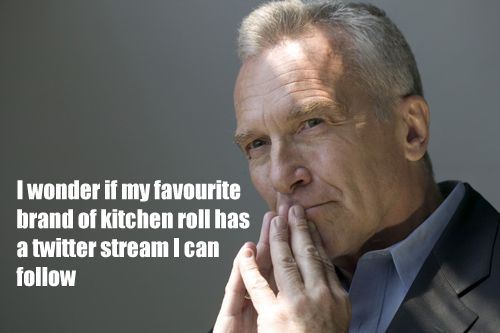So far today, depending on how your Saturday is going and how long you have been awake, you have probably interacted with 50 – 200 different products and brands.
If you have a child you have likely interacted with more. This count excludes any advertisements you encountered today. Just stuff you have used or consumed so far today that you purchased somewhere: coffee, coffee maker, mug, toothpaste, moisturizer, shampoo, towel, plate, sheets, running shoes, car, phone, computer, book, television, coffee shop, stroller . . . it adds up fast.
In the grand scheme of everything that occurs in your life, some products are unimportant to you. Actually a lot of products are unimportant. They might be important when you use them and you might love them but you aren’t putting a lot of thought in to the brand. We recently saw this image in a sarcastic post on thechive.com that illustrates this really well : Things Really People Don’t Say About Advertising:
Think about an average day last week. How much thought did you give to the company that makes your bath towels? How much thought did you give to your bath towels? What about your exercise shoes? Your phone? Your washing machine? Some more than others but none of those took up much of your emotion or thoughts. Consumers have a lot going on and the last thing they want to think about is products if they can get away with not thinking about them.
Don’t get me wrong – we love great products. We will recommend great products to our friends. We will be loyal to a brand if the product is great (and the price is commenserate with its value.) But, we aren’t spending a lot of our mental energy thinking about these products if we don’t have to because we are thinking about the other things in our lives. Here are a few examples of how this played out in my day today:
- I used a my favorite handheld running water bottle while running. I love that thing. I will only use that brand. I’ve owned two of them and might buy a spare. I thought about it today for 10 seconds – 5 while I filled it with water and 5 while I put it away.
- I cooked a new type of gluten-free, vegan frozen pizza today (yes, seriously. Don’t be jealous.) and I loved it. After I took the first bite I said, out loud, to myself, “Oh my goodness. This is AMAZING!” and then I thought “if I ever see this again in the store I’ll buy it.” I haven’t thought about that pizza brand since that moment.
- I put on a pair of shoes today that I love. I’ve had them for two years. They are perfect for walking around the city in the summer and fall. Good with a skirt and yet also good with pants. Every time I put them on I think “These are such good shoes.” And yet, I have no idea who makes them.
In the context of all the things I interacted with and all the things I did today those three brands took up about 2 minutes of my emotion and mental energy (and it was only that long because I ate the entire pizza.)
These examples shouldn’t be surprising to you because you probably did the same thing ten times over today. In our personal lives, as consumers, this makes total sense. However, when we put our work hat on and go into our jobs where we make, market, sell, and deliver products to people we often forget the relative importance of our product to the people who use it. We usually work on one product or product category which allows us not to have to think about our product in the context of every other product, decision, activity, and emotion vying for our customers’ attention. We get tunnel vision with our product at the center of the tunnel and at the center of the customers’ world.
However, it is important to recalibrate our thinking on this or else we will design products and experiences that require a lot of effort and passion on the customers’ part … and that just isn’t the reality. When you think about your product in your customer’s world remember to keep it in context (see our article on Customer Experience in Context here).
Keep this visual in mind the next time you are thinking about your customers: This is how your product looks in your customer’s life (little red box below,) even if they love it and use it all the time:


